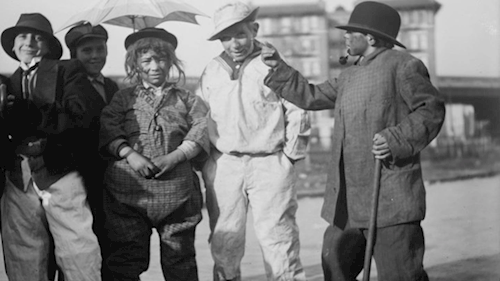

Thanksgiving used to look a lot more like Halloween. The practice of dressing up in costumes and asking for candy didn't become common in the U.S. until the 1940s and 1950s; before then, people trick-or-treated—or, well, did something that resembled trick-or-treating—on the national day of gratitude.
They called it "Thanksgiving Masking."
The masking started, it seems, in the mid-19th century—an outgrowth of "mumming," the centuries-old tradition in which costumed men went from door to door, asking for food and/or money. (Sometimes, but not always, the men would play music in exchange for the stuff.)
By the end of the 19th century, the process had evolved to look downright Halloween-y. People would don masks—especially popular: parrots and other birds and animals—and parade around town. Boys would wear girls' clothing, "tog[ging] themselves out in worn-out finery of their sisters" and spending the day "gamboling in awkward mimicry of their sisters to the casual street piano."
People also got more, um, creative with their costumes. "Masks of prominent men and the foremost political leaders are made by some manufacturers, and large-sized false hands, feet, noses, ears, etc., are also new and amusing," the Los Angeles Times noted in 1897. "There were Fausts, Filipinos, Mephistos, Boers, Uncle Sams, John Bulls, Harlequins, bandits, sailors, soldiers in khaki suits," The New York Times reported in 1899. Some people wore masks that made fun of people of other nations "with greatly exaggerated facial peculiarities."
The mood, during these festivities, was light. And most everyone involved, according to the Times, "was generous with pennies and nickels, and the candy stores did a land-office business."
Though especially popular in New York, other cities took part in Thanksgiving masking, too. Newspapers of the time described elaborate masquerade balls held in places like Cape Girardeau, Missouri and Montesano, Washington. As one syndicated column, tracked down by NPR's Linton Weeks, put it: "Thousands of folks ran rampant. Horns and rattles are worked overtime. The throwing of confetti and even flour on pedestrians is an allowable pastime."
Thanksgiving masking was also, for some, good business. Candy stores, vertically integrating, began to sell costumes next to their spiced jelly gums and crystallized ginger—thus helping to turn a practice into a tradition. ("All toy shops," Appleton's Magazine reported in 1909, "carry a line of hideous and terrifying false faces or 'dough faces' as they are termed on the East Side.") According to a widely distributed item from the Los Angeles Times in 1897, Weeks notes, Thanksgiving was "the busiest time of the year for the manufacturers of and dealers in masks and false faces. The fantastical costume parades and the old custom of making and dressing up for amusement on Thanksgiving day keep up from year to year in many parts of the country, so that the quantity of false faces sold at this season is enormous."
One of the most popular costumes for children: the beggar. Kids dressed up in old clothes or rags, playing the part of "ragamuffins"—a practice that became so widespread that Thanksgiving came to be nicknamed "Ragamuffin Day." Parades of faux-poor children dated back at least to 1891, the New York Public Library historian Carmen Nigro told Weeks. Indeed, as the New York Tribune reported in 1901, "every street had its band of children, dressed as ragamuffins, who kept in the open air for hours."
The practice, however, wasn't popular with everyone. By the 1920s, the public at large was growing weary of the parades—and with the rowdiness and pranks that often came with them. William J. O'Shea, Superintendent of schools at the time, sent a circular to New York's superintendents and principals arguing that "modernity is incompatible with the custom of children to masquerade and annoy adults on Thanksgiving day."
He was right, it turned out; what he didn't anticipate was that the practice of costumed revelry would simply be transferred to another holiday. As a Times Square policeman told a New York Times reporter in 1930, with a hint of longing in his voice, "All I've seen is just about six kids dressed up like we used to dress in the old days. Things ain't the way they used to be."
This website is powered by Spruz
Megan Garber is a staff writer at The Atlantic, where she covers culture.